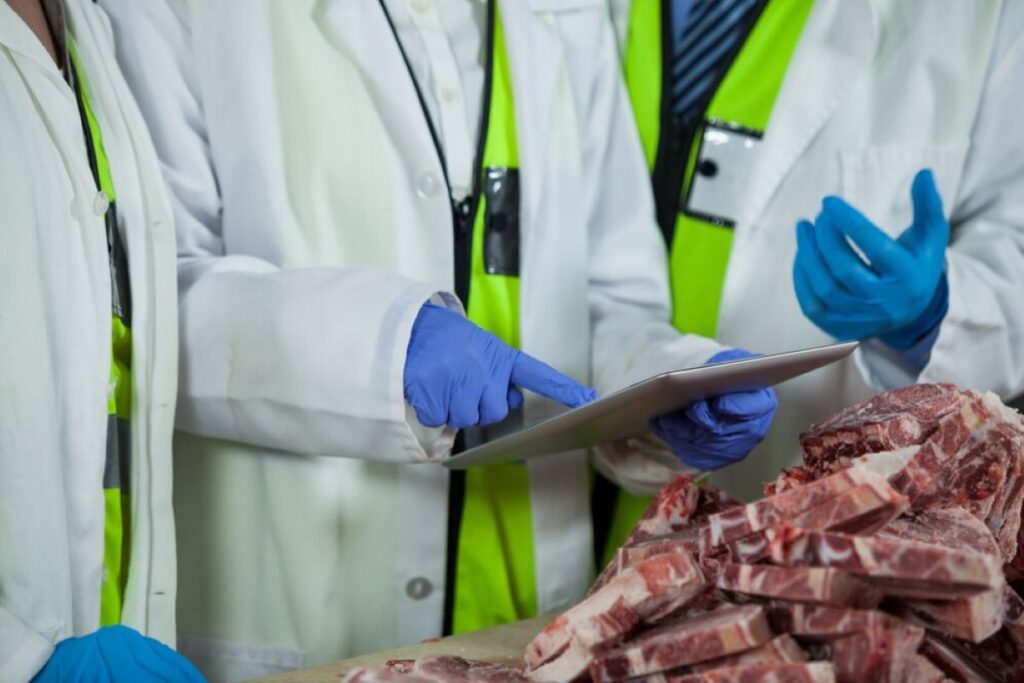Food safety regulatory compliance is crucial for protecting public health and maintaining integrity in the food industry. National regulations set strict guidelines to prevent foodborne illnesses and instil confidence in the food supply chain.
These extensive regulations provide a framework for:
- Safe food handling practices
- Contamination prevention measures
- Quality control standards
- Documentation requirements
- Emergency response protocols
The implementation of strong food safety management systems directly impacts public health statistics, with properly regulated establishments showing significantly lower rates of food-related incidents. Research indicates that businesses adhering to national food safety requirements experience:
“A 70% reduction in food safety incidents and a 60% increase in consumer trust ratings” – Food Safety Authority Annual Report 2023
Consumer confidence drives market success, making regulatory compliance essential for businesses. Modern food safety requirements go beyond basic hygiene practices and include:
- Digital monitoring systems
- Real-time temperature tracking
- Supply chain traceability
- Staff training documentation
- Regular compliance audits
The evolving landscape of food safety requires flexible approaches that combine traditional safety measures with innovative technological solutions to meet and surpass national standards.
Understanding Food Safety Regulatory Compliance
Food safety regulatory compliance involves following laws, standards, and rules that are put in place to keep the public healthy by ensuring food is handled safely. These regulations set the basic requirements that businesses in the food industry must follow to operate legally.
Key Components of Regulatory Compliance:
- Preventive Controls: Implementation of science-based systems to identify and mitigate potential food safety hazards
- Documentation Requirements: Maintaining accurate records of food safety practices and procedures
- Training Standards: Regular staff education on proper food handling and safety protocols
- Quality Assurance Measures: Systematic monitoring of food production processes
The main purpose of these compliance standards is to stop people from getting sick from food by using strict control methods. These methods include:
- Verifying where raw materials come from
- Keeping an eye on temperature levels
- Preventing cross-contamination
- Managing allergens properly
- Cleaning and sanitising as needed
Food safety compliance has a direct impact on the quality of products by using consistent production methods and checking for quality at different stages. These regulations create a system for:
- Having clear specifications for products
- Ensuring manufacturing processes are reliable
- Testing for quality based on risks
- Validating the integrity of the supply chain
Modern compliance standards take into account new scientific discoveries and emerging challenges in food safety, adjusting to new threats while still sticking to basic safety principles. This flexible approach makes sure that food businesses are always ready to provide safe, high-quality products that meet changing consumer expectations and regulatory requirements.
Key National Food Safety Regulations
United States
The U.S. Food Safety Modernization Act (FSMA) represents a significant shift in food safety regulation, emphasising prevention rather than reaction to contamination. Signed into law in 2011, FSMA grants the FDA enhanced authority to:
- Mandate comprehensive preventive controls
- Conduct risk-based facility inspections
- Request mandatory recalls
- Oversee imported food safety
Key Enforcement Agencies in the United States
The following agencies play a crucial role in enforcing food safety regulations in the United States:
- Food and Drug Administration (FDA)
- Department of Agriculture (USDA)
- Centers for Disease Control and Prevention (CDC)
Canada
The Safe Food for Canadians Regulations (SFCR) establishes Canada’s modernised approach to food safety. These regulations:
- Require licensing for food businesses
- Implement preventive controls
- Mandate traceability documentation
- Strengthen import and export controls
Key Enforcement Agencies in Canada
In Canada, the enforcement of food safety regulations is carried out by the following agencies:
- Canadian Food Inspection Agency (CFIA)
- Health Canada
- Public Health Agency of Canada
Similarities and Differences between FSMA and SFCR
Both regulatory frameworks share common elements but differ in implementation:
- FSMA focuses on risk-based prevention through detailed hazard analysis.
- SFCR emphasises licensing and traceability requirements.
The U.S. system divides responsibility between multiple agencies based on food type, whereas Canada centralises oversight through CFIA.
Impact of Regulations on the Food Industry
These regulations create standardised expectations across the food industry, requiring businesses to maintain detailed documentation, implement robust safety protocols, and undergo regular inspections to ensure compliance.
Core Elements of National Food Safety Requirements
National food safety requirements encompass essential components designed to protect public health through systematic controls and standardised practices. These core elements create a comprehensive framework for food businesses to maintain safety standards.
1. Licensing and Registration Requirements
- Mandatory business registration with relevant food safety authorities
- Specific permits based on food handling activities
- Regular licence renewals with updated compliance documentation
- Qualified food safety supervisors on premises
2. Preventive Control Plans
- Written food safety procedures
- Hazard analysis at critical control points
- Risk mitigation strategies
- Employee training protocols
- Regular internal audits

3. Supply Chain Traceability
- Detailed record-keeping of suppliers and customers
- Batch coding systems
- Real-time inventory tracking
- Emergency recall procedures
- Documentation retention policies
4. Hygiene and Sanitation Standards
- Personal hygiene protocols for staff
- Facility cleaning schedules
- Equipment sanitisation procedures
- Pest control programmes
- Waste management systems
5. Labelling Requirements
- Ingredient declarations
- Allergen warnings
- Nutritional information panels
- Storage instructions
- Best-before dates
- Country of origin labelling
- Net weight declarations
These requirements form an interconnected system where each element reinforces the others. Modern food businesses implement digital solutions to manage these requirements efficiently, using automated systems for documentation, monitoring, and reporting. Technology-driven compliance tools help maintain consistent standards while reducing human error and streamlining regulatory adherence. Click here to get more about ensuring food safety standards compliance in hospitality.
Compliance Challenges and Solutions in Food Safety Management
Food safety management presents distinct operational hurdles for businesses across the supply chain. Documentation requirements create substantial administrative burdens, with staff spending significant time manually recording temperatures, cleaning schedules, and safety checks. Training demands add another layer of complexity – ensuring all employees maintain current food safety certifications requires careful tracking and coordination.
Key Documentation Challenges:
- Maintaining accurate daily temperature logs
- Recording cleaning and sanitisation procedures
- Tracking employee training certifications
- Managing supplier compliance records
- Documenting corrective actions
Automated record-keeping systems transform these paper-based processes into streamlined digital workflows. Cloud-based platforms enable real-time data entry through mobile devices, eliminating duplicate work and reducing human error. Digital systems automatically flag missing records and send alerts when temperatures exceed safe ranges.
The integration of technology solutions delivers measurable improvements:
- Time Savings: 75% reduction in time spent on compliance paperwork
- Error Reduction: Automated data validation catches mistakes before they become issues
- Improved Visibility: Real-time dashboards highlight compliance gaps
- Enhanced Traceability: Digital records enable instant access during audits
- Simplified Training: Built-in modules track certification status
Smart sensors and IoT devices further automate compliance monitoring by continuously collecting and uploading critical data points. These technological advances allow food businesses to shift focus from administrative tasks to proactive safety management.
Leveraging Technology for Compliance Excellence: Innovations in Food Safety Management Software
Modern food safety management software transforms regulatory compliance through innovative features and capabilities. Advanced digital platforms offer customisable solutions that adapt to specific business requirements:
Comprehensive Compliance Solutions
- Real-time monitoring dashboards
- Digital checklists with automated scheduling
- Built-in corrective action protocols
- Integrated audit management tools
- Automated compliance reporting systems
Hardware Integration Capabilities
- Smart temperature sensors with continuous monitoring
- IoT-enabled equipment tracking
- Automated label printing systems with allergen alerts
- Mobile scanning devices for inventory management
- Digital probe thermometers with instant data upload
Secure SaaS Platform Benefits
- Cloud-based data storage with encrypted protection
- Multi-device accessibility for remote management
- Real-time updates and notifications
- Automated backup systems
- Cross-platform compatibility
These technological innovations create a seamless compliance ecosystem. The integration of hardware and software components establishes a robust framework for maintaining food safety standards. Digital solutions eliminate manual processes, reduce human error, and provide accurate documentation for regulatory requirements.
The implementation of secure SaaS platforms enables businesses to access critical compliance data from any location. This accessibility empowers teams to respond swiftly to potential food safety issues and maintain consistent monitoring across multiple sites. Additionally, the use of advanced security measures such as sensitivity labels ensures that sensitive compliance data is adequately protected while being easily accessible.
Industry Applications, Benefits, Steps to Achieve Full Regulatory Compliance
Technology-driven solutions are transforming food safety compliance across various industries, each with its own specific needs and challenges.
Healthcare and Aged Care Facilities
- Real-time temperature monitoring of medical-grade refrigerators
- Automated documentation of meal preparation and delivery
- Digital allergen tracking for patient safety
- Streamlined dietary requirement management
Hospitality and Food Service
- Mobile checklist completion for daily safety protocols
- Instant HACCP compliance verification
- Digital staff training records
- Automated cleaning schedule management
Retail and Supermarkets
- Integrated cold chain monitoring
- Automated stock rotation alerts
- Digital display cabinet temperature logging
- Real-time compliance reporting
Manufacturing and Production
- End-to-end traceability documentation
- Automated quality control checkpoints
- Digital batch coding and tracking
- Integrated supplier compliance management
The implementation of integrated compliance systems delivers substantial benefits:
Cost Reduction
- 60% decrease in manual documentation time
- Reduced food waste through precise monitoring
- Lower risk of compliance-related penalties
- Minimized recall-related expenses

Operational Efficiency
- Automated data collection and analysis
- Centralised record-keeping
- Simplified audit preparation
- Rapid incident response capabilities
These technology-driven solutions create measurable improvements in compliance adherence while reducing operational costs. The digital transformation of food safety management enables businesses to maintain consistent standards across multiple locations, ensure rapid response to potential issues, and demonstrate regulatory compliance with comprehensive digital records.
Conclusion
The path to robust food safety regulatory compliance lies in embracing technological innovation. Digital solutions transform traditional compliance processes into streamlined, efficient operations that protect both businesses and consumers. These advanced systems enable:
- Real-time monitoring and documentation
- Automated record-keeping with enhanced accuracy
- Seamless integration across multiple facilities
- Rapid response to potential safety issues
The adoption of technology-enabled compliance strategies creates a foundation for sustainable operational excellence. Businesses that implement comprehensive digital solutions position themselves at the forefront of food safety management while reducing operational costs and strengthening consumer trust.
The future of food safety compliance rests in the hands of organisations willing to embrace digital transformation. Through innovative solutions like automated monitoring systems and integrated compliance platforms, businesses can build resilient operations that meet and exceed national requirements—ensuring safer food practices for generations to come.


